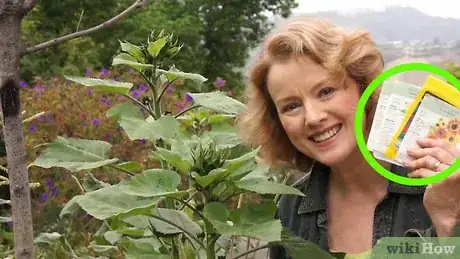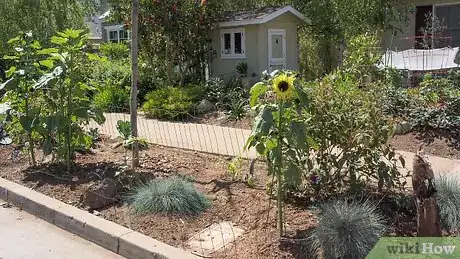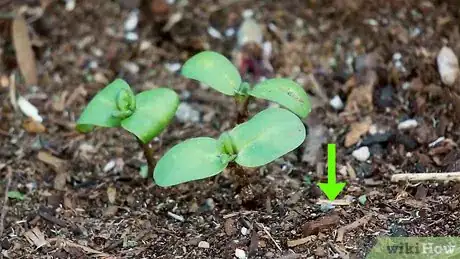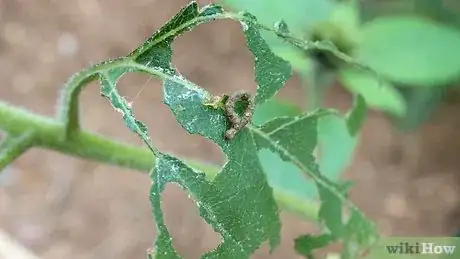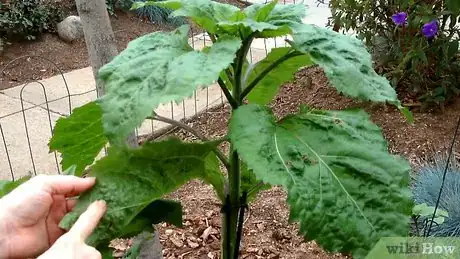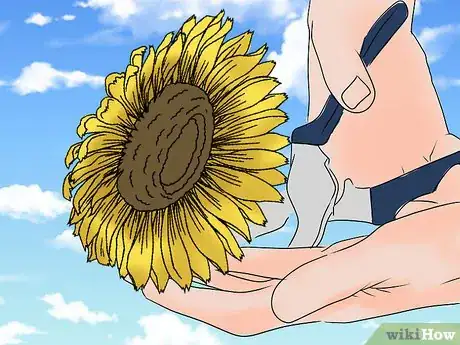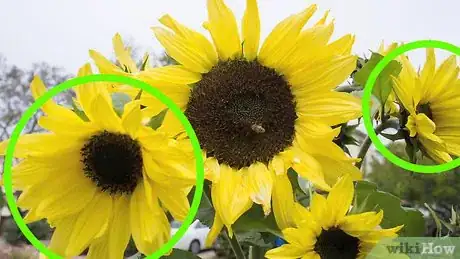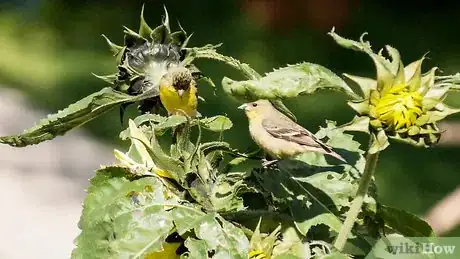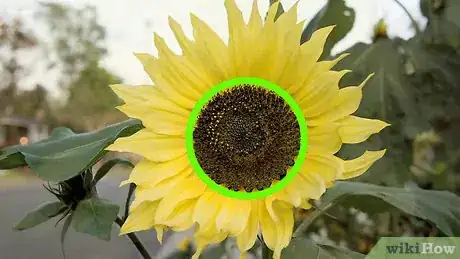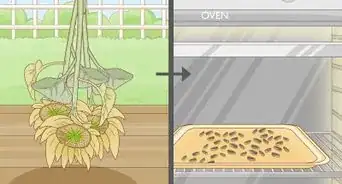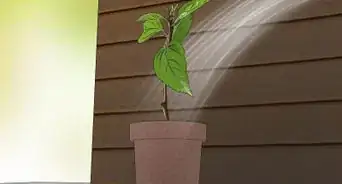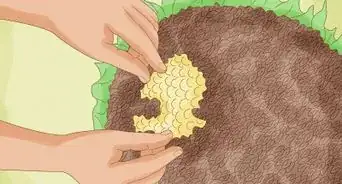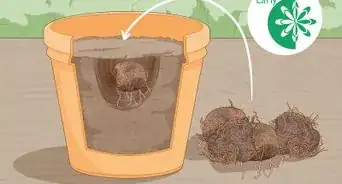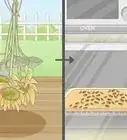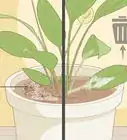This article was co-authored by Artemisia Nursery. Artemisia Nursery is a retail plant nursery in Northeast Los Angeles specializing in California native plants. Artemisia Nursery is a worker-owned small business with plans to become a worker-owned cooperative. In addition to California native plants, Artemisia Nursery offers a selection of succulents, heirloom veggie and herb starts, house plants, pottery, and gardening tools and supplies. Drawing on the knowledge of the founders, Artemisia Nursery also offers consultations, designs, and installations.
There are 14 references cited in this article, which can be found at the bottom of the page.
wikiHow marks an article as reader-approved once it receives enough positive feedback. In this case, 96% of readers who voted found the article helpful, earning it our reader-approved status.
This article has been viewed 288,019 times.
A sunflower is a magnificent plant, with as many as two thousand miniature flowers forming the central disc.[1] Many common sunflower varieties grow quickly and resist drought and disease fairly well. Protect them from wind and pests, and you'll have a beautiful addition to your summer garden.
Steps
Planting Sunflowers
-
1Choose a variety. Sunflowers range from eighteen foot (5.5 m) stalks to a knee-high cluster of pom-poms. Besides the size and appearance, there are a few other considerations:
- The classic, yellow, single-stem sunflower usually grow quickly and easily. Sunrich and Pro Cut are good beginner options.[2]
- Branching varieties produce many flowers per seed, but most grow more slowly. If you plan to cut the flowers, get a pollen-free or low-pollen variety such as Cherry Rose to avoid a sticky mess.[3]
- Larger varieties such as Mammoth Gray Stripe and Humongous tend to produce tastier seeds, and can provide support for climbing plants.[4] [5] (Some smaller varieties produce birdseed-quality seeds.)
-
2Decide when to plant the sunflowers. You can plant your sunflowers starting in late spring, once the last frost is passed. However, many sunflowers are daylight-sensitive, and may grow leggy and delay flowering if planted at the wrong time. There are three types of varieties:[6]
- Short-day: These need long nights to trigger flowering. Plant them toward the end of summer (or start them indoors in mid-spring).
- Long-day: These bloom during the middle of summer.
- Day-neutral varieties can be planted any time during the growing season.
- Plan ahead based on the expected flowering time. Most single-stem sunflowers bloom 60 days after planting from seed, while branched sunflowers bloom after 90 days.[7]
Advertisement -
3Choose a spot with well-drained soil and full sun. Sunflowers grow best in loamy soil with good drainage and neutral pH.[8] More importantly, make sure the area gets at least six hours of full sun a day, and preferably eight or more.[9]
- If the soil is poor, mix in 3 or 4 inches (7.5–10cm) of compost into the topsoil.[10]
-
4Plant the seeds. Farmers usually plant large, single-stem sunflowers at least an inch (2.5 cm) deep.[11] In home gardens with good quality soil (not too dry or sandy), you can likely plant at ½ inch (1.25 cm) depth instead.[12]
- Plant extra seeds if you have the space. You may thin them later, or lose some seeds to pests.
-
5Space the seeds apart depending on desired flower size. The further apart you space the seeds, the larger their flowers will grow:
- Plant the seeds 6 inches (15 cm) apart for smaller, bouquet-sized flowers, or 9" (23) cm + for larger blooms.[13]
- If your sunflower's max height is above 5 ft (1.5m), plant them at least 1 ft (0.3m) apart. Giant varieties may need 2 ft (0.6m) of space.[14]
- Most branching varieties need 18" (46 cm) of space.[15]
Caring for Sunflowers
-
1Water young sunflowers daily. Sunflower seedlings need plenty of water while they're establishing themselves. Keep the soil moist, but not soaked, until the seedlings emerge. This usually happens within 5–10 days of planting, but may take longer in cold weather. Once the seedling emerges, water about 3–4 inches (7.5–10cm) from the plant to encourage root growth.[16]
-
2Fertilize the sunflowers if the soil is poor. Sunflowers do not need fertilizer, and overdoing the nitrogen can create a leggy plant with delayed flowering. If your soil is poor, add compost or slow-release fertilizer to the surface of the soil.[17] This should help strengthen the plant without overdosing it.
-
3Protect sunflowers from pests. Protecting your plants against slugs and snails is especially important. You can surround your plants with slug repellent from a garden store, or make your own "beer traps" for slugs to fall in.
-
4Look out for yellow leaves. Downy mildew can be a major problem in clay or waterlogged soils. Check regularly for this fungus, which causes shrunken yellow leaves in addition to its namesake down. If you see these symptoms, reduce water use to keep soil dry, and apply fungicide immediately. Infected plants rarely produce flowers, so you may want to simply remove them to avoid spreading the disease.[18] [19]
- If the leaves look normal except for a striking yellow bleached color, this is a bacterial infection instead. Keeping soil dry will help here as well, and the plant will usually be fine.
- If the leaf looks yellow but still has green veins, the problem is most likely a mineral deficiency. It can be tricky to pinpoint the exact problem, but diluted fertilizer may work.
- Be aware that it’s normal for sunflowers to lose their first set of leaves once they begin growing in earnest. Don’t worry if the bottom leaves yellow and drop, but the rest of the leaves are fine.
-
5Reduce watering for mature sunflowers. Once they've developed a deep taproot, sunflowers are fairly drought-resistant. They'll still thrive on regular, deep watering, especially while buds and flowers are developing, but allow the soil to dry out between watering sessions. Over-watering is more likely to harm them than under-watering.[20]
- Try not to get the blooms wet, as this can damage them.[21]
-
6Stake the sunflowers in windy weather. Wind can severely damage most multi-branched varieties, as well as any sunflower over 3 ft (0.9m) tall. Tie them to a sturdy support using cloth or other soft material.[22] You may need to put up a wind barrier for extra tall sunflowers.
Harvesting Flowers and Seeds
-
1Cut decorative flowers when they are ¼ open. At this stage, the flower petals stick up perpendicular to the central disc. Cut them at this point for maximum vase life (usually five days, much longer with some varieties):[23]
- Cut flowers in the early morning or early evening.
- Use a clean knife or shears.
- Strip off any leaves that would be below the water line.
- Place in water immediately.
-
2Cut flowers for drying. In this case, it's best to wait until the flower is about half open, and the petals are leaning outward.[24] Once cut, there are many ways to preserve them. The simplest is to tie the stems with twine and hang them upside down in a warm room with good ventilation.
-
3Protect seeds from birds and squirrels. If you'd like to harvest the seeds yourself, you'll have to battle the neighborhood animals. Once the flowers start to droop and lose their petals, cover the head with cheesecloth or a paper bag.
- Most sunflowers will produce many more seeds if you attract bees to your garden to pollinate them.
-
4Harvest the seed head. You may cut off the seed head once the disk it rests on starts to turn color from green to yellow. Store in a dry, cool location until the disk turns dark brown. The seeds are now ready to eat, raw or roasted.
- Store seeds in a cloth bag to allow air to circulate. This helps prevent mold.
Expert Q&A
Did you know you can get expert answers for this article?
Unlock expert answers by supporting wikiHow
-
QuestionHow do you grow sunflowers in pots?
 Artemisia NurseryArtemisia Nursery is a retail plant nursery in Northeast Los Angeles specializing in California native plants. Artemisia Nursery is a worker-owned small business with plans to become a worker-owned cooperative. In addition to California native plants, Artemisia Nursery offers a selection of succulents, heirloom veggie and herb starts, house plants, pottery, and gardening tools and supplies. Drawing on the knowledge of the founders, Artemisia Nursery also offers consultations, designs, and installations.
Artemisia NurseryArtemisia Nursery is a retail plant nursery in Northeast Los Angeles specializing in California native plants. Artemisia Nursery is a worker-owned small business with plans to become a worker-owned cooperative. In addition to California native plants, Artemisia Nursery offers a selection of succulents, heirloom veggie and herb starts, house plants, pottery, and gardening tools and supplies. Drawing on the knowledge of the founders, Artemisia Nursery also offers consultations, designs, and installations.
Plant Nursery & Garden Shop Sunflowers do best if they're transplanted from their pot into the earth when they're really little, like when they get their first set of real leaves. Alternatively, if you can't transplant them into the ground, I would recommend going with as large of a container as possible to grow the sunflower in and to choose a dwarf variety sunflower.
Sunflowers do best if they're transplanted from their pot into the earth when they're really little, like when they get their first set of real leaves. Alternatively, if you can't transplant them into the ground, I would recommend going with as large of a container as possible to grow the sunflower in and to choose a dwarf variety sunflower. -
QuestionDo you cut back sunflowers in the winter?
 Katie GohmannKatherine Gohmann is a Professional Gardener in Texas. She has been a home gardener and professional gardener since 2008.
Katie GohmannKatherine Gohmann is a Professional Gardener in Texas. She has been a home gardener and professional gardener since 2008.
Professional Gardener
-
QuestionA lot of my seeds are hollow or have tiny insect holes in them. Should I have sprayed the sunflowers? I have an organic garden.
 Katie GohmannKatherine Gohmann is a Professional Gardener in Texas. She has been a home gardener and professional gardener since 2008.
Katie GohmannKatherine Gohmann is a Professional Gardener in Texas. She has been a home gardener and professional gardener since 2008.
Professional Gardener
Things You'll Need
- Sunflower Seeds
- Water
- Stake
References
- ↑ http://www.pollinator.ca/bestpractices/sunflowers.html
- ↑ https://www.johnnyseeds.com/growers-library/flowers/library-flowers-choose-sunflowers.html
- ↑ http://www.hobbyfarms.com/12-sunflowers-for-your-garden-2/
- ↑ http://www.hobbyfarms.com/12-sunflowers-for-your-garden-2/
- ↑ http://www.hobbyfarms.com/12-sunflowers-for-your-garden-2/
- ↑ https://play.google.com/store/books/details?id=Iv8j2QkMNM8C
- ↑ http://www.johnnyseeds.com/t-library-flowers-choose-sunflowers.aspx
- ↑ https://www.ag.ndsu.edu/extensionentomology/recent-publications-main/publications/A-1331-sunflower-production-field-guide
- ↑ http://cestanislaus.ucanr.edu/files/111738.pdf
- ↑ http://cestanislaus.ucanr.edu/files/111738.pdf
- ↑ http://sanangelo.tamu.edu/extension/agronomy/agronomy-publications/sunflower-production-guide/
- ↑ http://crops.extension.iastate.edu/cropnews/2013/02/soil-and-management-factors-influence-seeding-depth
- ↑ http://www.johnnyseeds.com/assets/information/sunflowers-single-stem-commercial-production.pdf
- ↑ http://cestanislaus.ucanr.edu/files/111738.pdf
- ↑ http://www.johnnyseeds.com/t-library-flowers-choose-sunflowers.aspx
- ↑ http://www.almanac.com/plant/sunflowers
- ↑ http://www.burpee.com/gardenadvicecenter/annuals/sunflowers/all-about-sunflowers/article10035.html
- ↑ https://www.ag.ndsu.edu/extensionentomology/recent-publications-main/publications/A-1331-sunflower-production-field-guide
- ↑ http://sanangelo.tamu.edu/extension/agronomy/agronomy-publications/sunflower-production-guide/
- ↑ https://www.ag.ndsu.edu/extensionentomology/recent-publications-main/publications/A-1331-sunflower-production-field-guide
- ↑ http://www.johnnyseeds.com/assets/information/sunflowers-single-stem-commercial-production.pdf
- ↑ http://www.burpee.com/gardenadvicecenter/annuals/sunflowers/all-about-sunflowers/article10035.html
- ↑ http://www.johnnyseeds.com/assets/information/sunflowers-single-stem-commercial-production.pdf
- ↑ http://www.johnnyseeds.com/assets/information/sunflowers-single-stem-commercial-production.pdf
- ↑ Artemisia Nursery. Plant Nursery & Garden Shop. Expert Interview. 7 August 2020.
- Videos provided by Kaye Kittrell | Late Bloomer Urban Organic Garden Show
About This Article
To care for sunflowers, plant them 1 inch deep, after the last frost, and in loamy soil with good drainage and full sun. Keep the soil moist as they are establishing themselves, but let the soil dry out between waterings once they're mature. If you want to harvest the flowers to keep in a vase, cut them when the petals are perpendicular to the central disk so they will last longer. Alternatively, for seed saving, cut them when the petals are leaning outward. Keep reading for tips from our Horticulturist reviewer on how to protect your sunflowers from pests!
